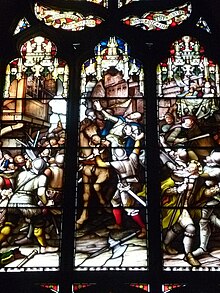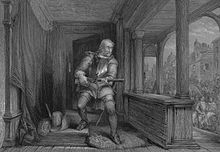James Hamilton of Bothwellhaugh
James Hamilton of Bothwellhaugh (* unknown; † between 1581 and 1585) was a Scottish nobleman who shot the then regent of Scotland, James Stewart, 1st Earl of Moray , on January 23, 1570 in Linlithgow .
Life
His parents were David Hamilton of Bothwellhaugh († 1563), who was nicknamed "good man", and Janet Hamilton († 1539), a natural daughter of James Hamilton, 1st Earl of Arran . Around 1560 he married Isabel Sinclair.
Like many of his family, he fought on May 13, 1568 at the Battle of Langside on the side of Maria Stuart against her half-brother James Moray. After the lost battle, Hamilton was captured and sentenced to death, but later pardoned. However, his property remained confiscated. After the battle, Mary Queen of Scots fled to England, where she was captured, and Moray remained Regent of Scotland.
In January 1570 a group of discontented people planned to assassinate the regent. Among them was Bothwellhaugh's uncle, the Archbishop of St. Andrews , John Hamilton . Bothwellhaugh was entrusted with carrying out the assassination attempt. He lay in wait in a house in Linlithgow that belonged to his uncle and shot the passing James Stewart with an arquebus . He killed the horse of a rider next to steward and injured him so badly that he died of the injuries. After the fact, Bothwellhaugh fled on horseback from the regent's men who were chasing him.
Bothwellhaught had to leave Scotland after the fact and later wrote to Mary Queen of Scots:
"I have lost my wife and bairns and all I had to live on for Her Majesty's service."
"I have lost my wife and children and my livelihood in Her Majesty's service."
Although she expressed satisfaction with the act, she lacked the means and opportunities for the announced financial support from Bothwellhaugh.
Bothwellhaugh's motives

There are a number of controversial suspicions about Bothwellhaugh's reasons for the assassination. On the one hand, his clan had often been hostile to Moray's policy in recent disputes over supremacy in Scotland and supported Maria Stuart's party. Bothwellhaug's uncle, James Hamilton, 2nd Earl of Arran , had sided with Moray after Mary Queen's wedding with Darnley , took part in the uprising against the Queen in 1565 and then had to flee, but after his return he was exile in France 1569 in April of the same year - ten months before the assassination attempt - was imprisoned. If Bothwellhaugh had intended to strengthen the position of his family with the murder of Moray, it becomes clear in the course of history that this goal was not achieved. His uncle James remained in custody until 1573, and his uncle John was executed on the gallows in Stirling on April 6, 1571 after the end of the civil war .
On the other hand, Bothwellhaugh is said to have had a personal motive for revenge. After his property was confiscated, Moray distributed a large part of it to his favorites, including the property of Woodhouselee, which Bothwell's wife, Isabel Sinclair, inherited. The new owner, Sir John Bellenden, had originally contested her inheritance and was now preferred by Moray. Whether the story as it is described here, for example:
"Sir John Bellenden received the grant of Hamilton's land, and Woodhouselee was included. He found the Lady of Woodhouselee in possession, having brought forth a child on the day proceeding his coming. He turned mother and child forth into the snow in a midwinter night, and they perished and died in the woods. "
“Sir John Bellenden received most of Hamilton's land and Woodhouselee was one of them. He found the Lady de Woodhauselee on the property where she had given birth the day before his arrival. He chased the mother and child out into the snow on a midwinter night and they froze to death and died in the woods. "
true is doubtful, given that Isabel Sinclair survived her husband and died in 1589 or later.
After the assassination
There is little reliable information about life after the attack. Bothwellhaugh fled to the continent and placed himself in Paris in the service of the Guisen family , from which Maria Stuart's mother was descended. These are said to have tried before Bartholomew Night to instigate him to assassinate Coligny , the leader of the Huguenot party , which Bothwellhaugh refused. Another assassination attempt that was brought against him and his brother, who was involved in the murder of Moray and who often accompanied him, was an attack on William the Prince of Orange. At the peace treaty of Perth, in which many members of his family with King James VI. reconciled, he remained banished.
What is certain is that Bothwellhaugh was imprisoned in Brussels in 1576 for his involvement in the war against the Netherlands and did not obey a summons by the Scottish king in 1579 to comment on the charge of treason. In 1581 he was seen for the last time in Paris and in 1585 his lands were returned to his heirs. Whether he actually returned to Scotland before his death, and thus whether the tradition that he was buried in Monkton cemetery in Ayrshire , is true, remains to be seen.
Individual evidence
- ^ A b c Peter Holmes: Hamilton, James of Bothwellhaugh . Oxford DNB.
- ^ JB Rose, EM Rose: A Trinute to the Memory of Mary Queen of Scots. Being an attempt to relate, simply and truly the history of her life. For private circuit. Clowes and Sons, London 1868. p. 129.
- ^ Ritchie, Leitch: Scott and Scotland. Longman, London 1835, p. 223 f.
literature
- Peter Holmes Hamilton, James of Bothwellhaugh in: Oxford Dictionary of National Biography , Oxford University Press, 2004 [1] Accessed April 9, 2009.
- George Hamilton: A History of the House of Hamilton Skinner, Edinburgh 1933.
| personal data | |
|---|---|
| SURNAME | Hamilton, James of Bothwellhaugh |
| BRIEF DESCRIPTION | Murderer of James Stewart, 1st Earl of Moray |
| DATE OF BIRTH | 16th Century |
| DATE OF DEATH | between 1581 and 1585 |
